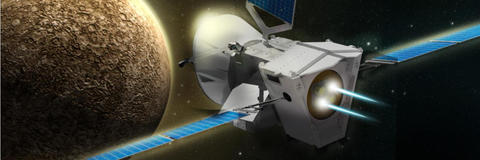Dosrad
Dosrad computes the radiation dose received by electronic components or material when exposed to the environment Dose integration performed by an efficient solid angle sectoring analysis:
- Rays are traced from the dose point outwards through the spacecraft
- For each ray, the amount of shielding encountered is determined taking into account the material density
- From the dose depth curve, the weighted dose contribution is calculated
The average doses per mesh and then per face are obtained Surfaces with thickness or volumes Computation: equipment dose/shielding, component dose, dose mapping, advanced features, honeycomb management, rays display.
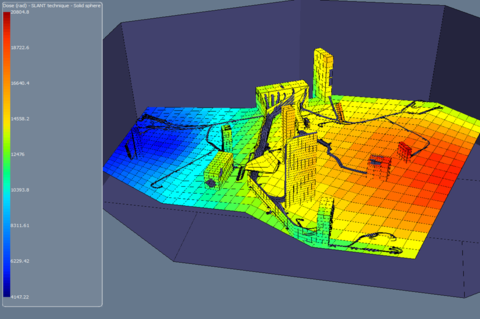
Plume Suite : PlumeFlow & Plumimp
Plume suite allows for modelling a thruster 2D-axisymetric field plume (plumflow) and its impact on the spacecraft (Plumimp).
Plumflow
The objective of the PLUMFLOW software is to compute the flow field issued from a thruster in vacuum, that is to say:
- Chemical composition of the gas in the chamber and in the plume
- Physical properties of the gas: viscosity, heat capacity, g, species diameter
- If necessary, description of the non-gaseous phase : particles or droplets
- Properties of the plume along the streamlines (velocity, density, pressures…)
- Characteristics of the engine (thrust, mass flow rate…)
This calculation involves a large panel of different methods:
- The computation of the chemical composition and physical properties is performed under assumption of thermodynamic equilibrium
- The computation of the flow inside the engine and its expansion in the surrounding space uses the method of characteristics or Navier-Stokes equation resolution. These programs perform the simulation of the boundary layer expansion at the nozzle lip
- The extension of the flow-field beyond the Navier-Stokes and the Method of Characteristics computational domain uses the source-flow method, considering the expansion as isotropic
- Other methods can be used to handle more specific problems like Direct Simulation Monte-Carlo at the nozzle lip or droplets propagation
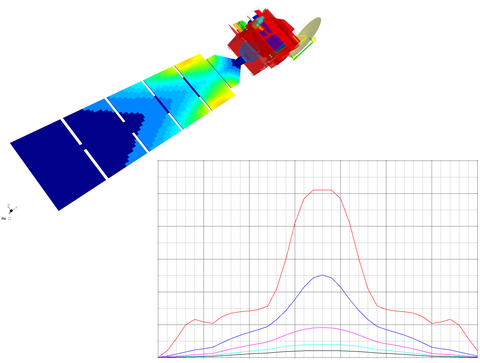
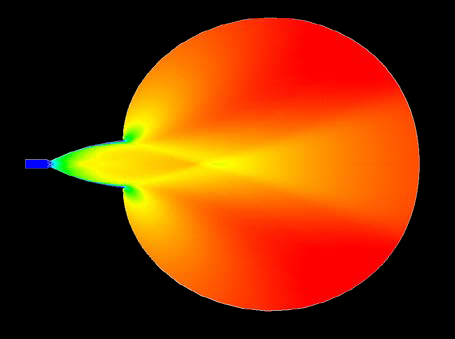
Plumimp
The objective of the Systema-Plume Impingement Software is :
- To predict the interaction between the chemical thrusters and the spacecraft in terms of dynamic, thermal and contamination effects
- To develop an engineering tool easy to use and validated
The main perturbating effects due to the impungment of thrusters plumes are numerous :
- Perturbing forces and torques due to the plume impingement on the spacecraft surfaces
- Heat convective flux due to the impingement of the gas and radiative flux due to the particles
- Modification of the surfaces properties due to the contaminants deposit
- Effects of the contaminants cloud on the optical devices (absorption, emission, scattering)
- Induced pressure at instrument / equipment level
Plumimp allow the modelling of such effects using an analytical ray-tracing technique. Rays are traced from the thruster of interest to all the meshes of the geometry. Each ray provides information regarding the current mesh and the thruster: incidence angle, distance to the thruster, etc... If another surface is encountered, the current mesh is said to be shadowed. Otherwise, the impact parameters as well as the derivate quantities are computed, cumulated (on meshes, on surfaces and possibly on groups) and stored in the corresponding file: in the Impingement information file for the impact parameters and in the Derivate quantities file for the other quantities.
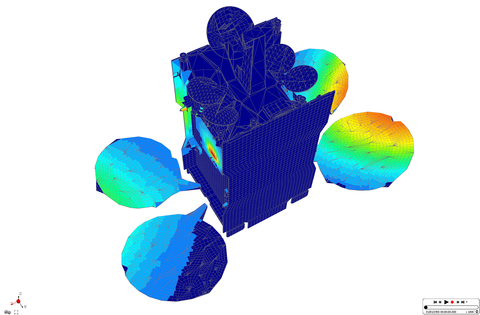
GTD
The GTD application deal with electromagnetism problems:
The tool consists of a complete radio-frequency prediction tool for large structure. It is used to propagate the electromagnetism field from the antenna sources to different points of interests such as
- Other antennas: to compute the decoupling between them
- Targets: to evaluate the incoming field and decoupling at a specific location
- Far sphere: to evaluate the antenna pattern
The propagation of the field is made by a ray-tracing method and uses the Geometrical Theory of Diffraction.
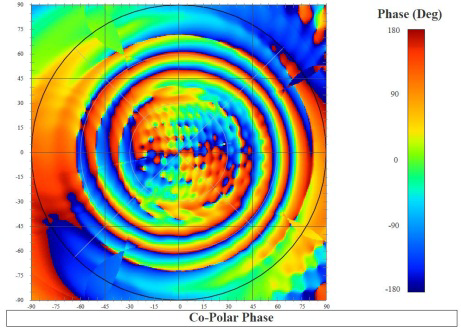
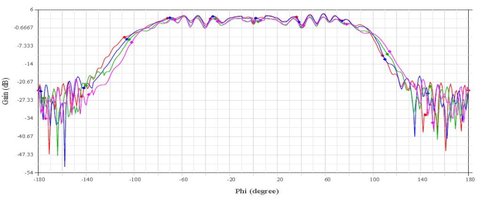
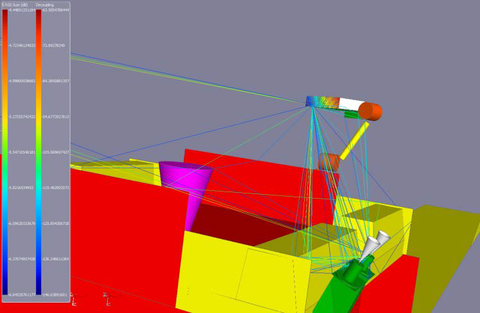
Debris
Debris predicts the risk of spacecraft equipment/structure failure.
The continuing growth in space debris and therefore the risk increase of mission-critical damage tend to develop the use of numerical tools in M/OD risk assessment methodology for spacecraft. Larger on-orbit objects are tracked and orbit change manoeuvres of the spacecraft can be performed to avoid a collision. For non-trackable objects, shields or other means to control risks are used. In order to improve the conception of the spacecraft, impact risk assessment tools are developed.
The prevention of critical damage on sensitive surfaces that might compromise mission objectives and lifetime, interest more and more the satellite design engineers.
To optimise the positioning of critical elements with respect to the overall performance efficiency, it is essential to have a comprehensive understanding and quantitative characterisation of the M/OD impact risk.
Debris is intended to provide a tool for evaluating the Probability of No-Penetration (PNP) of selected elements within spacecraft geometry, considering computation time compatible with the need to perform trade-off between configurations.
M/OD risk assessment analysis done via Debris allows:
- computation of the number of direct impacts on an element
- computation of the number of penetrations on an element
- computation of damaged area on an element
- computation of the PNP of an element
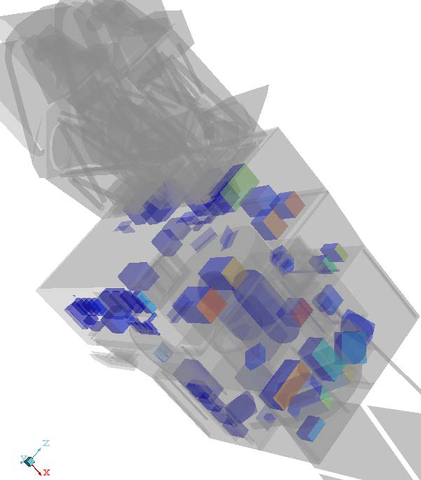
Outgassing
In vacuum, the coatings and materials may outgas contaminants species. The objective of the Outgassing software is to evaluate the deposit of contaminants on the spacecraft surfaces, such as mirrors and thermal coatings, as a function of time. The calculation proceeds in two main steps: the computation of the mass transfer factors between surfaces using Monte-Carlo method and the time integration of the deposit.
Computation of the direct mass transfer is done via:
- An advanced ray-tracing solver
- Multi-threaded computation
- Using management of all the shell shapes of the V4 including boolean shapes
- Allowing the display of mass transfer factors on the 3D models
- Allowing the display of rays contributing to the mass transfer factors
Computation of the deposits is done :
- With multi-threading computation (by species) of the deposits computation
- Allowing the display of deposit and remaining mass to be outgassed on the 3D model as function of time
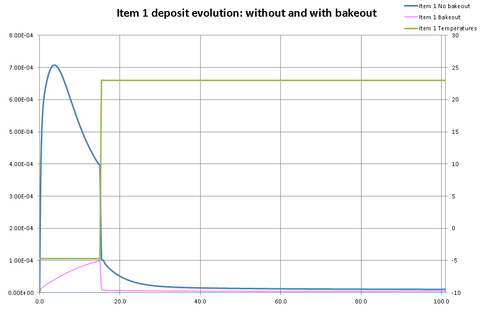
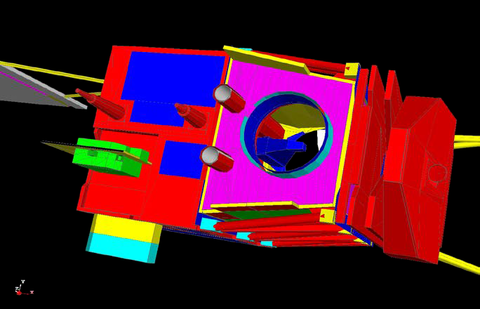
Atomox
A good knowledge of temperature, total density, concentrations of gas constituents, and pressure, can be important for many space missions in the low-earth orbit regime, below 1000 km altitude.
Atomox is an enhanced 3D numerical analysis tool for evaluation of atomic oxygen (and other species of the atmosphere) flux, fluence and material erosion, based on existing atmosphere and wind models. It involves mission and pointing modules, the ray-tracing technique and 2D and 3D visualization facilities.
All spacecraft surfaces are meshed into elements and the analysis is performed for each element. The mission and pointing modules provide the discretized location of the spacecraft together with its velocity with respect to the Earth. At the end of each orbital arc, orbital averaged or accumulated values are calculated which can be extrapolated when several arcs are specified.
The ray-tracing technique (Monte-Carlo technique) is used. It considers emitted rays from the surface of the satellite and detects if a given element is struck by the ray. Then, the ray can be followed by multiple reflections on the satellite surfaces (specular and diffuse reflectance taken into account). Outputs are the:
- Total impacting flux and fluence
- Absorbed flux and fluence
- Direct impacting flux and fluence
- Spacecraft material erosion
- Mean impact velocity (amplitude and direction)
- Mean particle energy
The model includes the effects of thermal motion of ambient particles in addition to the ambient atmospheric density and the velocity of the spacecraft. Thermal molecular motion can be responsible of erosion of surfaces that are shadowed during the mission.
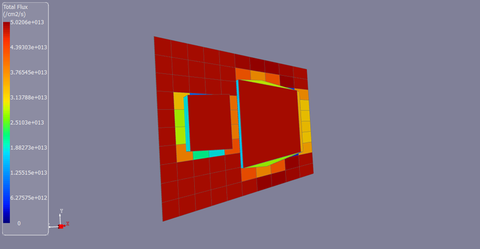
Perturbations
The objective of the Perturbations application is to deliver analysis of perturbations caused by Solar Pressure, and Air Drag generated by atmosphere remains at low atmosphere.
Solar Pressure
Sun radiation incident on the satellite's surfaces produces a radiation pressure, or force per unit area, equal to the vector difference between the incident and reflected momentum flux. The major factors determining the radiation pressure are:
- The intensity, the spectral and the spatial distribution of the incident radiation
- The geometry of the satellite
- The optical properties of the satellite surfaces
Solar pressure allows to account for the induced Forces and Torques using a state-of-the-art analytical raytracing algorithm.
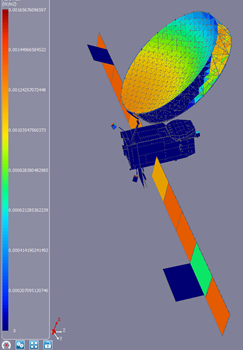
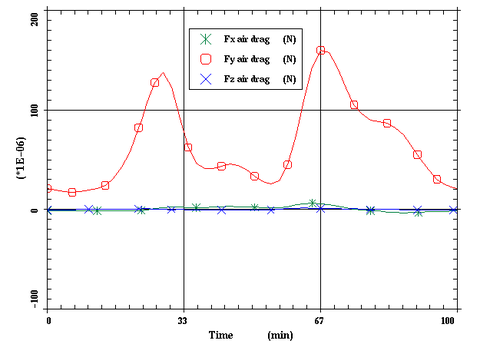
Air Drag
A satellite moving through the Earth upper atmosphere is subjected to aerodynamic forces. These forces result from the interaction of the atmosphere molecules with the satellite's surfaces. Therefore the air drag depends on the following parameters:
- the satellite velocity
- the atmospheric constituents, their density and their kinetic temperature
- the motion of the atmosphere
- the geometry of the satellite
- the orientation of the satellite w.r.t. the incoming flow
- the surface characteristics and temperature
This force is usually modelled by assuming that it acts in a direction opposite to the spacecraft's velocity vector relative to the ambient atmosphere. The results are computed using a modified Maxellian model for Particule/Wall Interaction.
